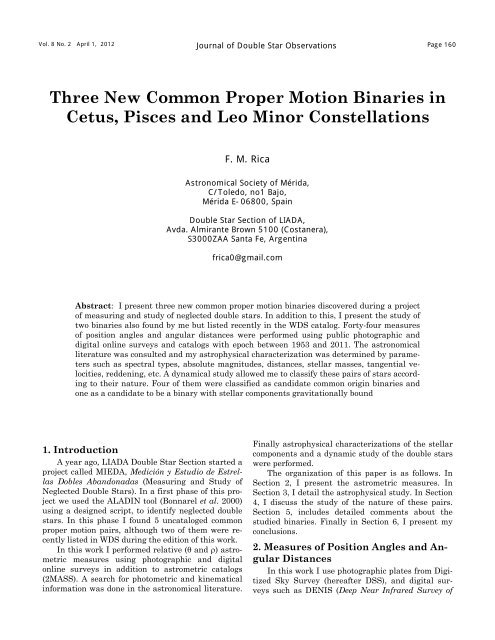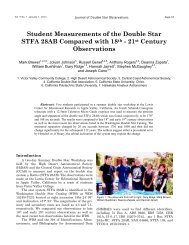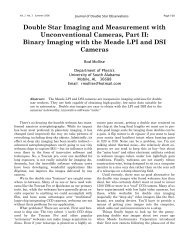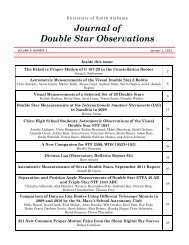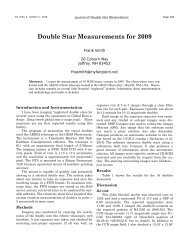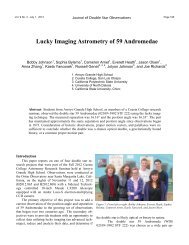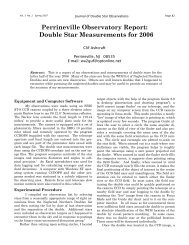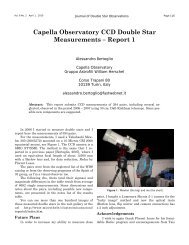Three New Common Proper Motion Binaries in Cetus ... - JDSO.org
Three New Common Proper Motion Binaries in Cetus ... - JDSO.org
Three New Common Proper Motion Binaries in Cetus ... - JDSO.org
Create successful ePaper yourself
Turn your PDF publications into a flip-book with our unique Google optimized e-Paper software.
Vol. 8 No. 2 April 1, 2012<br />
Journal of Double Star Observations<br />
Page 160<br />
<strong>Three</strong> <strong>New</strong> <strong>Common</strong> <strong>Proper</strong> <strong>Motion</strong> <strong>B<strong>in</strong>aries</strong> <strong>in</strong><br />
<strong>Cetus</strong>, Pisces and Leo M<strong>in</strong>or Constellations<br />
F. M. Rica<br />
Astronomical Society of Mérida,<br />
C/Toledo, no1 Bajo,<br />
Mérida E-06800, Spa<strong>in</strong><br />
Double Star Section of LIADA,<br />
Avda. Almirante Brown 5100 (Costanera),<br />
S3000ZAA Santa Fe, Argent<strong>in</strong>a<br />
frica0@gmail.com<br />
Abstract: I present three new common proper motion b<strong>in</strong>aries discovered dur<strong>in</strong>g a project<br />
of measur<strong>in</strong>g and study of neglected double stars. In addition to this, I present the study of<br />
two b<strong>in</strong>aries also found by me but listed recently <strong>in</strong> the WDS catalog. Forty-four measures<br />
of position angles and angular distances were performed us<strong>in</strong>g public photographic and<br />
digital onl<strong>in</strong>e surveys and catalogs with epoch between 1953 and 2011. The astronomical<br />
literature was consulted and my astrophysical characterization was determ<strong>in</strong>ed by parameters<br />
such as spectral types, absolute magnitudes, distances, stellar masses, tangential velocities,<br />
redden<strong>in</strong>g, etc. A dynamical study allowed me to classify these pairs of stars accord<strong>in</strong>g<br />
to their nature. Four of them were classified as candidate common orig<strong>in</strong> b<strong>in</strong>aries and<br />
one as a candidate to be a b<strong>in</strong>ary with stellar components gravitationally bound<br />
1. Introduction<br />
A year ago, LIADA Double Star Section started a<br />
project called MIEDA, Medición y Estudio de Estrellas<br />
Dobles Abandonadas (Measur<strong>in</strong>g and Study of<br />
Neglected Double Stars). In a first phase of this project<br />
we used the ALADIN tool (Bonnarel et al. 2000)<br />
us<strong>in</strong>g a designed script, to identify neglected double<br />
stars. In this phase I found 5 uncataloged common<br />
proper motion pairs, although two of them were recently<br />
listed <strong>in</strong> WDS dur<strong>in</strong>g the edition of this work.<br />
In this work I performed relative (θ and ρ) astrometric<br />
measures us<strong>in</strong>g photographic and digital<br />
onl<strong>in</strong>e surveys <strong>in</strong> addition to astrometric catalogs<br />
(2MASS). A search for photometric and k<strong>in</strong>ematical<br />
<strong>in</strong>formation was done <strong>in</strong> the astronomical literature.<br />
F<strong>in</strong>ally astrophysical characterizations of the stellar<br />
components and a dynamic study of the double stars<br />
were performed.<br />
The <strong>org</strong>anization of this paper is as follows. In<br />
Section 2, I present the astrometric measures. In<br />
Section 3, I detail the astrophysical study. In Section<br />
4, I discuss the study of the nature of these pairs.<br />
Section 5, <strong>in</strong>cludes detailed comments about the<br />
studied b<strong>in</strong>aries. F<strong>in</strong>ally <strong>in</strong> Section 6, I present my<br />
conclusions.<br />
2. Measures of Position Angles and Angular<br />
Distances<br />
In this work I use photographic plates from Digitized<br />
Sky Survey (hereafter DSS), and digital surveys<br />
such as DENIS (Deep Near Infrared Survey of
Vol. 8 No. 2 April 1, 2012<br />
Journal of Double Star Observations<br />
Page 161<br />
<strong>Three</strong> <strong>New</strong> <strong>Common</strong> <strong>Proper</strong> <strong>Motion</strong> <strong>B<strong>in</strong>aries</strong> <strong>in</strong> <strong>Cetus</strong>, Pisces and Leo M<strong>in</strong>or Constellations<br />
the Southern Sky) <strong>in</strong> I, J, and K bands and SDSS<br />
(Sloan Digital Sky Survey) <strong>in</strong> ugriz bands. In addition<br />
to this, the astrometry of 2MASS catalog was<br />
used to obta<strong>in</strong> θ and ρ measures.<br />
Antonio Agudo Azcona (AAA) performed an astrometric<br />
measure of FMR 27 <strong>in</strong> 2011 us<strong>in</strong>g a Schmidt-<br />
Cassegra<strong>in</strong> of 20 cm of diameter. The image was<br />
taken us<strong>in</strong>g a CCD Atik 16IC-S monochrome and a<br />
reduced focal Hirsch SCT f/6.3. This configuration<br />
gave a focal length of 1384 mm, a scale of 1.24 arcsec<br />
and a field of view of 16.1' x 12.0'.<br />
Ramón Palomeque Messía (RPM) also performed<br />
an astrometric measure of FMR 27 us<strong>in</strong>g a Schmidt-<br />
Cassegra<strong>in</strong> of 20 cm of diameter. The image was<br />
taken us<strong>in</strong>g a Orion SSDS-II Color camera. He took<br />
500 images of 1 second exposure time and later<br />
stacked 100 images us<strong>in</strong>g Maxim. Reduc was used for<br />
the astrometric measure.<br />
Table 1 lists Forty-four position angles (θ) and<br />
angular distances (ρ) measures with observational<br />
epochs between 1953 and 2011. This table gives the<br />
WDS name (or the proposed name for those b<strong>in</strong>aries<br />
not listed <strong>in</strong> WDS) <strong>in</strong> column (1), the Besselian observational<br />
epoch, the position angle and angular distances<br />
<strong>in</strong> columns (2)-(4); the aperture of the telescope<br />
(<strong>in</strong> <strong>in</strong>ches) <strong>in</strong> column (5) and f<strong>in</strong>ally, <strong>in</strong> the last column<br />
the method used to obta<strong>in</strong> the relative astrometry:<br />
• DSS: photographic plates from Digitized Sky<br />
Survey<br />
• DENIS-band: digital images from DENIS.<br />
“band” is the photometric band used <strong>in</strong> the<br />
image (I, J, and K).<br />
• SDSS-band: digital images from SDSS.<br />
“band” is the photometric band used <strong>in</strong> the<br />
image .<br />
• 2MASS: astrometry from 2MASS catalog<br />
3. The Astrophysical Study<br />
A detailed astrophysical study of the new stellar<br />
systems and for the stellar components was performed<br />
(see Table 2). The guidel<strong>in</strong>es of the astrophysical<br />
study were published <strong>in</strong> Benavides et al. (2010) <strong>in</strong><br />
sections 3 to 10. The astrophysical data were corrected<br />
for <strong>in</strong>terstellar redden<strong>in</strong>g. The redden<strong>in</strong>g was<br />
nearly negligible except for LEP 121 which E(B-V) =<br />
0.09. In the followed subsections I add new po<strong>in</strong>ts to<br />
the astrophysical guidel<strong>in</strong>es.<br />
3.1 Photometry<br />
Photometric <strong>in</strong>formation was obta<strong>in</strong>ed from the<br />
follow<strong>in</strong>g catalogs:<br />
• the <strong>in</strong>frared J, H, and K photometry from 2MASS<br />
(Hog et al. 2000) catalog,<br />
• the V magnitude was determ<strong>in</strong>ed us<strong>in</strong>g the red magnitudes<br />
from CMC14 (CMC 2006) and UCAC3<br />
(Zacharias et al. 2009). For more detail, see the work<br />
published by Rica (2011a).<br />
• I consulted the SDSS (Adelman-McCarthy J.K. et al.<br />
2009) catalog. The ugriz photometry was converted<br />
to V, U-B, B-V, V-I Johnson photometry. For more<br />
detail about this transformation see the work published<br />
by Rica (2011a). Where SDSS photometry is<br />
available , we use the V magnitude determ<strong>in</strong>ed if the<br />
star is weaker that 15 magnitude <strong>in</strong> g band.<br />
4. Are These Double Stars Gravitationally<br />
Bound<br />
In Benavides et al. (2010), <strong>in</strong> section 9, and <strong>in</strong><br />
Rica (2011b) I described <strong>in</strong> detail the criteria used to<br />
determ<strong>in</strong>e the nature of the pairs. The relative motions<br />
of the systems were calculated plott<strong>in</strong>g rectangular<br />
coord<strong>in</strong>ates x = ρ * s<strong>in</strong> θ and y = ρ * cos θ (prior<br />
to correction of θ for precession and proper motion)<br />
aga<strong>in</strong>st time (read the Appendix <strong>in</strong> Rica (2011b)). The<br />
scope of the weighted l<strong>in</strong>ear fit (calculated us<strong>in</strong>g<br />
Mathematica 5.0) gave the value of the relative<br />
proper motion <strong>in</strong> arcsec*yr -1 . The <strong>in</strong>itial weights for<br />
measures were assigned us<strong>in</strong>g a data weight<strong>in</strong>g<br />
scheme published <strong>in</strong> Rica (2010).<br />
If the distance is known then I can convert the<br />
relative motion <strong>in</strong> relative velocity (<strong>in</strong> km s -1 or <strong>in</strong> AU<br />
yr -1 ), a key datum to determ<strong>in</strong>e if Keplerian motion is<br />
possible <strong>in</strong> these stellar systems. Often the uncerta<strong>in</strong>ties<br />
<strong>in</strong> the observational data don’t allow the determ<strong>in</strong>ation<br />
with certa<strong>in</strong>ty the nature of the pair. In that<br />
case, I determ<strong>in</strong>ed the probability that a double star<br />
is gravitationally bound.<br />
For this, I use celestial mechanics to determ<strong>in</strong>e if<br />
the relative projected velocity of B with respect to A is<br />
smaller than the maximum orbital velocity or the escape<br />
velocity. I analyzed the probability that a b<strong>in</strong>ary<br />
is a gravitationally bound system us<strong>in</strong>g a Monte<br />
Carlo simulation with 25,000 iterations. Monte Carlo<br />
methods are a class of computational procedures that<br />
rely on repeated random sampl<strong>in</strong>g to compute their<br />
results. For more detail, see section 5.2 of the work of<br />
Rica (2011b).<br />
(Cont<strong>in</strong>ued on page 164)
Vol. 8 No. 2 April 1, 2012<br />
Journal of Double Star Observations<br />
Page 162<br />
<strong>Three</strong> <strong>New</strong> <strong>Common</strong> <strong>Proper</strong> <strong>Motion</strong> <strong>B<strong>in</strong>aries</strong> <strong>in</strong> <strong>Cetus</strong>, Pisces and Leo M<strong>in</strong>or Constellations<br />
Table 1: Astrometric measures.<br />
Double Epoch θ (deg) ρ (as) Aperture Observer Method<br />
FMR 26 1954.675 205.77 20.19 48 FMR DSS<br />
1954.675 205.48 20.79 48 FMR DSS<br />
1977.637 204.69 20.29 48 FMR DSS<br />
1981.767 205.61 20.05 48 FMR DSS<br />
1982.633 205.40 20.37 48 FMR DSS<br />
1995.826 204.83 20.08 48 FMR DSS<br />
1996.866 205.07 20.39 48 FMR DSS<br />
1997.808 205.31 20.18 48 FMR DSS<br />
1998.626 205.50 20.23 51 FMR 2MASS<br />
1999.595 205.65 20.34 39 FMR DENIS-I<br />
1999.595 205.81 20.13 39 FMR DENIS-J<br />
FMR 27 1953.779 171.65 363.056 48 FMR DSS<br />
1953.779 171.58 362.785 48 FMR DSS<br />
1983.682 171.56 362.525 48 FMR DSS<br />
1990.810 171.54 363.164 48 FMR DSS<br />
1993.622 171.52 363.224 48 FMR DSS<br />
1995.801 171.57 363.220 48 FMR DSS<br />
1997.828 171.54 362.94 51 FMR 2MASS<br />
2011.907 171.50 362.85 8 AAA CCD<br />
2011.983 171.49 362.69 8 RPM CCD<br />
LEP 122 1958.524 200.6 7.3 48 FMR DSS<br />
1974.61 200.5 7.35 48 FMR DSS<br />
1979.629 194.0 6.98 48 FMR DSS<br />
1980.559 190.3 7.23 48 FMR DSS<br />
1987.378 199.5 7.15 48 FMR DSS<br />
1992.41 202.9 6.48 48 FMR DSS<br />
1996.699 199.9 6.64 48 FMR DSS<br />
1998.53 199.8 7.22 39 FMR DENIS-K<br />
1998.53 200.5 7.17 39 FMR DENIS-I<br />
1998.53 199.4 7.09 39 FMR DENIS-J<br />
1999.507 200.6 7.21 51 FMR 2MASS<br />
LEP 121 1976.483 134.2 3.53 48 FMR DSS<br />
1996.545 134.0 4.70 48 FMR DSS<br />
1998.414 130.7 4.09 51 FMR 2MASS<br />
FMR 28 1955.29 138.49 18.56 48 FMR DSS<br />
1983.849 139.14 18.43 48 FMR DSS<br />
1989.928 139.01 18.81 48 FMR DSS<br />
1993.197 138.82 18.68 48 FMR DSS<br />
1998.217 139.00 18.70 51 FMR 2MASS<br />
1999.96 138.79 18.73 48 FMR DSS<br />
2004.083 138.90 18.70 98 FMR SDSS-g<br />
2004.083 138.91 18.58 98 FMR SDSS-g<br />
2004.083 139.05 18.63 98 FMR SDSS-g<br />
2004.083 138.75 18.64 98 FMR SDSS-g
Vol. 8 No. 2 April 1, 2012<br />
Journal of Double Star Observations<br />
Page 163<br />
<strong>Three</strong> <strong>New</strong> <strong>Common</strong> <strong>Proper</strong> <strong>Motion</strong> <strong>B<strong>in</strong>aries</strong> <strong>in</strong> <strong>Cetus</strong>, Pisces and Leo M<strong>in</strong>or Constellations<br />
FMR 26 FMR 27 LEP 122 LEP 121 FMR 28<br />
A B A B A B A B A B<br />
RA2000 01h 06m 20.62s 01 h 07 m 27.07 s 18h 29m 16.90s 17 h 08 m 25.59 s 10 h 00 m 19.13 s<br />
DEC 2000 -22º 24’ 45.0” +24º 53’ 41.8” -30º 59’ 48.9” -22º 09’ 24.0” +31º 19’ 42.2”<br />
V 16.53 a) 19.2 b) 12.72 a) 15.42 a) 13.87 a) 14.65 a) 16.5 g) 17.5 g) 15.63 f) 18.93 f)<br />
B – V --- --- --- --- --- --- --- --- --- ---<br />
V – I --- --- --- --- --- --- --- --- --- ---<br />
K c) 12.38 13.45 10.65 12.11 9.49 9.94 12.21 12.79 13.21 15.18<br />
J – H c) +0.60 +0.55 +0.42 +0.61 +0.48<br />
+0.51<br />
0.51<br />
+0.47 +0.48 +0.57 +0.51<br />
H – K c) +0.22 +0.28 +0.07 +0.16 +0.28 +0.22 +0.24 +0.25 +0.15 +0.23<br />
J – K c) +0.82 +0.83 +0.50 +0.77 +0.76 +0.73 +0.71 +0.73 +0.72 +0.74<br />
V-K +4.15 +5.80 +2.07 +3.31 +4.38 +4.71 +4.3 +4.7 +3.14 +4.49<br />
-36.4 -30.7 +130 +138<br />
μ(α) [mas/yr]<br />
± 4 d) ± 4 d) ± 2 d) ± 4 d) +457 d) -29.5 -28.5<br />
+460 +368 +361<br />
± 4.2 d) ± 4.3 d)<br />
μ(δ) [mas/yr]<br />
Table 2: Astrophysical data for the stellar component of the b<strong>in</strong>aries.<br />
-99.0 -98.5 -4 -5<br />
± 4 d) ± 4 d) ± 2 d) ± 4 d) -158 d) -155 +366 +367<br />
-56.3<br />
±4. 2<br />
d)<br />
-62.4<br />
± 4.3 d)<br />
Spectral Type e) M2V M4.5V G9V K7V M2.5V M3V M3VI M5VI K6V M2.5V<br />
Distance [pc] e) 192 118 212 228 43 41 108 113 385 383<br />
Mv e) 10.06 13.80 5.95 8.46 10.64 11.53 11.04 11.96 7.64 10.95<br />
BC e) -1.76 -2.46 -0.22 -0.65 -1.90 -2.03 -2.1 -2.5 -0.57 -1.90<br />
Mass e) 0.37 0.18 0.84 0.66 0.37 0.26 --- --- 0.70 0.37<br />
Vtan [km s -1 ] e) 96 58 130 149 99 94 250 275 116 125<br />
E(B-V) 0.01 0.01 0.04 0.05 0.02 0.02 0.09 0.09 0.02 0.02<br />
Notes:<br />
a) Determ<strong>in</strong>ed us<strong>in</strong>g UCAC3 (Zacharias el at. 2010) and 2MASS (Cutri 2000) photometry<br />
b) Determ<strong>in</strong>ed us<strong>in</strong>g USNO-B1.0 (Monet et al. 2003) photometry<br />
c) 2MASS catalog<br />
d) catalog PPMXL (Roeeser, Demleitner, & Schilbach 2010)<br />
e) this work<br />
f) SDSS catalog<br />
g) WDS catalog;
Vol. 8 No. 2 April 1, 2012<br />
Journal of Double Star Observations<br />
Page 164<br />
<strong>Three</strong> <strong>New</strong> <strong>Common</strong> <strong>Proper</strong> <strong>Motion</strong> <strong>B<strong>in</strong>aries</strong> <strong>in</strong> <strong>Cetus</strong>, Pisces and Leo M<strong>in</strong>or Constellations<br />
(Cont<strong>in</strong>ued from page 161)<br />
5. Notes on Stellar System<br />
FMR 26<br />
This is a very fa<strong>in</strong>t (16.53 and 19.2 magnitudes)<br />
b<strong>in</strong>ary located <strong>in</strong> the constellation <strong>Cetus</strong> (Figure 1). It<br />
is composed of M2V and M4.5V stars separated by<br />
about 20.2” with a common proper motion of -31 mas<br />
yr -1 <strong>in</strong> AR and -99 mas yr -1 <strong>in</strong> DEC. The secondary<br />
has a V magnitude of 19.2, determ<strong>in</strong>ed us<strong>in</strong>g the<br />
USNO-B1.0 photometry. But, if we use the GSC2.3<br />
photometry, a V magnitude of 18.2 and a M3V spectral<br />
type is obta<strong>in</strong>ed for the secondary component.<br />
The V magnitudes determ<strong>in</strong>ed us<strong>in</strong>g a photographic<br />
catalog such as USNO-B1.0 and GSC2.3, have an uncerta<strong>in</strong>ty<br />
of about 0.3-0.4 magnitudes. To this value<br />
we have to add the systematic errors usually found <strong>in</strong><br />
the photographic plates. I decided to use the V magnitude<br />
from USNO-B1.0 because the VJHK photometries<br />
are a better fit to the spectral types – photometry<br />
relations. These sources of error make our<br />
astrophysical data have larger errors than <strong>in</strong> other<br />
studies.<br />
The Monte Carlo simulation <strong>in</strong>dicates a common<br />
distance probability of about 60 % (146.5 ± 18.1 pc)<br />
and a probability of b<strong>in</strong>arity (stellar components<br />
gravitationally bound) of less than 1%. The significant<br />
probability of common distance and the common<br />
proper motion of about 105 mas yr -1 ( relative motion<br />
Δμ = 5.07 ± 4.89 mas yr -1 ) for the components, suggest<br />
a b<strong>in</strong>ary nature of common orig<strong>in</strong> (no orbit<strong>in</strong>g stars).<br />
FMR 27<br />
This high common proper motion pair, located <strong>in</strong><br />
the Pisces, is composed by stars of 12.72 and 15.42<br />
magnitudes with spectral types G9V and K7V (Figure<br />
2). It is a very wide pair of stars separated by about<br />
363”. The relative astrometric measures and the high<br />
relative motion calculated (12.6 ± 8.6 mas yr -1 ) suggest<br />
that this pair of stars could be not gravitationally<br />
bound (although the level of uncerta<strong>in</strong>ty don’t allow<br />
us conclude this with security). If the UCAC3 proper<br />
motion is used, then the relative motion is reduced to<br />
2.8 mas yr -1 . Even us<strong>in</strong>g this small relative motion,<br />
the criteria used conclude that the stellar components<br />
of FMR 27 are not gravitationally bound. So this pair<br />
of stars is likely a b<strong>in</strong>ary of common orig<strong>in</strong>.<br />
LEP 122 (WDS 18293-3100)<br />
This is a very high common proper motion b<strong>in</strong>ary<br />
(μ = 0.483 arcsec yr -1 ) discovered by Lep<strong>in</strong>e (2008) <strong>in</strong><br />
Figure 1: RGB image of the b<strong>in</strong>ary star FMR 26 where the apparent<br />
motion is clearly visible.<br />
Figure 2: RGB image of the extremely wide b<strong>in</strong>ary star FMR 27<br />
where the apparent motion is clearly visible
Vol. 8 No. 2 April 1, 2012<br />
Journal of Double Star Observations<br />
Page 165<br />
<strong>Three</strong> <strong>New</strong> <strong>Common</strong> <strong>Proper</strong> <strong>Motion</strong> <strong>B<strong>in</strong>aries</strong> <strong>in</strong> <strong>Cetus</strong>, Pisces and Leo M<strong>in</strong>or Constellations<br />
the constellation Sagittarius. WDS catalog lists spectral<br />
types K+K (Figure 3). In this work I determ<strong>in</strong>ed<br />
that this system is located 41 - 43 pc from us and is<br />
composed of 13.87 and 14.65 magnitude stars of spectral<br />
types of M2.5V and M3V. It is a close pair (about<br />
7”) with a poorly determ<strong>in</strong>ed relative motion of 4.7 ±<br />
6.2 mas yr -1 . The 25,000 Monte Carlo simulations that<br />
I ran showed that <strong>in</strong> 77 % of the simulations, the observed<br />
projected velocity was smaller than the maximum<br />
escape velocity. So this pair of stars is likely a<br />
b<strong>in</strong>ary with gravitationally bound stellar components.<br />
The projected distance calculated is 303 AU and us<strong>in</strong>g<br />
Kepler’s Third Law (assum<strong>in</strong>g circular and face-on<br />
orbit) a period of 9,400 years is obta<strong>in</strong>ed. A common<br />
orig<strong>in</strong> nature cannot be ruled out.<br />
Our measures, us<strong>in</strong>g 2MASS catalog and DENIS<br />
images, seem to be the same as those of Skiff (2011)<br />
listed <strong>in</strong> WDS catalog.<br />
LEP 121 (WDS 17084-2209)<br />
This is a very high common proper motion b<strong>in</strong>ary<br />
(0.488 arcsec yr -1 ) discovered by Lep<strong>in</strong>e (2008) <strong>in</strong> the<br />
constellation Leo (Figure 4). The WDS catalog lists<br />
spectral types K+K. In this work, I determ<strong>in</strong>ed that<br />
this system is located at 108 - 113 pc and is composed<br />
of two subdwarf candidate stars of M3VI and M5VI<br />
spectral types with magnitudes 16.5 and 17.5 (WDS).<br />
I determ<strong>in</strong>ed the subdwarf nature us<strong>in</strong>g reduced<br />
proper motion diagrams. LEP 121 is a close pair separated<br />
by 4.1” with a poorly determ<strong>in</strong>ed relative motion<br />
of 16 mas yr -1 . This relative motion was calculated<br />
from the proper motion of the stellar components.<br />
Astronomical literature does not list proper<br />
motion data, so the proper motions listed <strong>in</strong> this work<br />
have been calculated from two photographic plates<br />
taken on 1976.483 and 1996.545. The projected distance<br />
is 453 AU. I calculated a very similar photometric<br />
distance for the primary (108 pc) and the secondary<br />
(113 pc) components. This common distance, <strong>in</strong><br />
addition to the common proper motion, <strong>in</strong>dicates that<br />
LEP 121 is a b<strong>in</strong>ary star. But the large relative motion<br />
suggests that it is a common orig<strong>in</strong> b<strong>in</strong>ary with<br />
stellar component not gravitationally bound.<br />
Our measure with epoch 1998.414 was obta<strong>in</strong>ed<br />
us<strong>in</strong>g 2MASS catalog. WDS lists a measure from<br />
Skiff (2011) that seems to be also obta<strong>in</strong>ed us<strong>in</strong>g the<br />
2MASS catalog or image.<br />
FMR 28<br />
This is a distant and fa<strong>in</strong>t common proper motion<br />
(0.064 arcsec yr -1 ) b<strong>in</strong>ary located <strong>in</strong> the constellation<br />
Leo M<strong>in</strong>or at about 384 pc (Figure 5). It is composed<br />
of two dwarf stars of K6V and M2.5V spectral types<br />
Figure 3: RGB image of the b<strong>in</strong>ary star LEP 122 where the<br />
apparent motion is clearly visible<br />
Figure 4: RGB image of the b<strong>in</strong>ary star LEP 121.
Vol. 8 No. 2 April 1, 2012<br />
Journal of Double Star Observations<br />
Page 166<br />
<strong>Three</strong> <strong>New</strong> <strong>Common</strong> <strong>Proper</strong> <strong>Motion</strong> <strong>B<strong>in</strong>aries</strong> <strong>in</strong> <strong>Cetus</strong>, Pisces and Leo M<strong>in</strong>or Constellations<br />
with magnitudes 15.63 and 18.93. It is separated by<br />
18.6 - 18.7” with a relative motion of 2.26 ± 3.40 mas<br />
yr -1 . The projected distance is 7,181 AU. I calculated<br />
a very similar photometric distance for the primary<br />
(385 pc) and the secondary (383 pc) component. This<br />
common distance, <strong>in</strong> addition to the common proper<br />
motion <strong>in</strong>dicates that FMR 28 is surely a b<strong>in</strong>ary star.<br />
The 25,000 Monte Carlo simulations that I ran<br />
showed that only <strong>in</strong> the 5-6% of simulations the observed<br />
projected velocity was less than the maximum<br />
escape velocity. So FMR 28 is likely a common orig<strong>in</strong><br />
b<strong>in</strong>ary star.<br />
Conclusions<br />
Dur<strong>in</strong>g the course of the MIEDA project I found 5<br />
uncataloged wide common proper motion pairs. Dur<strong>in</strong>g<br />
the completion of this study two of them were recently<br />
<strong>in</strong>cluded to WDS catalog, so <strong>in</strong> this work I present<br />
three new common proper motion b<strong>in</strong>aries (FMR<br />
26, FMR 27 and FMR 28). Astrophysical characterizations<br />
and astrometric measurements were performed.<br />
In spite of the low quantity of the astrometric measures<br />
and the small time basel<strong>in</strong>e (less than 50 years),<br />
I performed a dynamical study to determ<strong>in</strong>e the probability<br />
to be pairs with stellar components gravitationally<br />
bound. All five pairs have stellar components<br />
with a significant possibility to be the same distance<br />
from us and with common proper motion. But only<br />
one pair (LEP 122) has the likely probability to be<br />
gravitationally bound. LEP 122 is a pair of red dwarf<br />
stars (M2.5V and M3V) separated by 303 AU and located<br />
at a distance of about 42 pc. Its orbital period is<br />
estimated to be about 9,400 years. The other pairs are<br />
surely b<strong>in</strong>ary stars of common orig<strong>in</strong>, that is, with<br />
stellar components that don’t orbit each other.<br />
Acknowledgements<br />
This project made use of data products from the<br />
Two Micron All Sky Survey, which is a jo<strong>in</strong>t project of<br />
the University of Massachusetts and the Infrared<br />
Process<strong>in</strong>g and Analysis Center/California Institute of<br />
Technology, funded by the National Aeronautics and<br />
Space Adm<strong>in</strong>istration and the National Science Foundation.<br />
DENIS is the result of a jo<strong>in</strong>t effort <strong>in</strong>volv<strong>in</strong>g human<br />
and f<strong>in</strong>ancial contributions of several Institutes<br />
mostly located <strong>in</strong> Europe. It has been supported f<strong>in</strong>ancially<br />
ma<strong>in</strong>ly by the French Institut National des<br />
Sciences de l'Univers, CNRS, and French Education<br />
M<strong>in</strong>istry, the European Southern Observatory, the<br />
State of Baden-Wuerttemberg, and the European<br />
Commission under networks of the SCIENCE and<br />
Figure 5: Photographic plate where FMR 28 appears at the<br />
center of the image.<br />
Human Capital and Mobility programs, the Landessternwarte,<br />
Heidelberg and Institut d'Astrophysique<br />
de Paris.<br />
The Digitized Sky Surveys were produced at the<br />
Space Telescope Science Institute under U.S. Government<br />
grant NAG W-2166. The images of these surveys<br />
are based on photographic data obta<strong>in</strong>ed us<strong>in</strong>g<br />
the Osch<strong>in</strong> Schmidt Telescope on Palomar Mounta<strong>in</strong><br />
and the UK Schmidt Telescope. The plates were processed<br />
<strong>in</strong>to the present compressed digital form with<br />
the permission of these <strong>in</strong>stitutions.<br />
This research made use of the Wash<strong>in</strong>gton Double<br />
Star Catalog ma<strong>in</strong>ta<strong>in</strong>ed at the U.S. Naval Observatory.<br />
We k<strong>in</strong>dly acknowledge Frank Smith for the English<br />
Grammar.<br />
References<br />
Adelman-McCarthy J. K. et al., 2009, ApJS, 182, 543<br />
Benavides R., Rica F., Re<strong>in</strong>a E., Castellano J., Naves<br />
R., Lahuerta L., Lahuerta S., 2010, <strong>JDSO</strong>, 6, 30<br />
Bonnarel F. et al., 2000, A&AS, 143, 33<br />
CMC, 2006, Copenhagen University Obs., Institute of<br />
Astronomy, Cambridge, Real Instituto y Observatorio<br />
de la Armada en San Fernando<br />
Cutri R. N. et al. Explanatory to the 2MASS Second<br />
Incremental Data Release, 2000, http://<br />
www.ipac.caltech.edu/2mass/releases/second/<br />
<strong>in</strong>dex.html
Vol. 8 No. 2 April 1, 2012<br />
Journal of Double Star Observations<br />
Page 167<br />
<strong>Three</strong> <strong>New</strong> <strong>Common</strong> <strong>Proper</strong> <strong>Motion</strong> <strong>B<strong>in</strong>aries</strong> <strong>in</strong> <strong>Cetus</strong>, Pisces and Leo M<strong>in</strong>or Constellations<br />
Høg E. et al., 2000, A&A, 355, 27<br />
Lep<strong>in</strong>e S., 2008, AJ, 135, 2177<br />
Monet D. G. et al., 2003, AJ, 125, 984<br />
Rica F. M., 2010, RMxAA, 46, 263<br />
Rica F. M., 2011a, <strong>JDSO</strong>, 7, 114<br />
Rica F. M., 2011b, <strong>JDSO</strong>, 7, 254<br />
Roeeser S., Demleitner M., Schilbach E., 2010, AJ,<br />
139, 2440<br />
Skiff B. A., 2011, private communication<br />
Zacharias N. et al., 2009, VizieR Onl<strong>in</strong>e Data Catalog,<br />
1/315, http://vizier.ustrasbg. fr/viz-b<strong>in</strong>/VizieR-<br />
source=I/315<br />
Zacharias N. et al., 2010, AJ, 139, 2184


